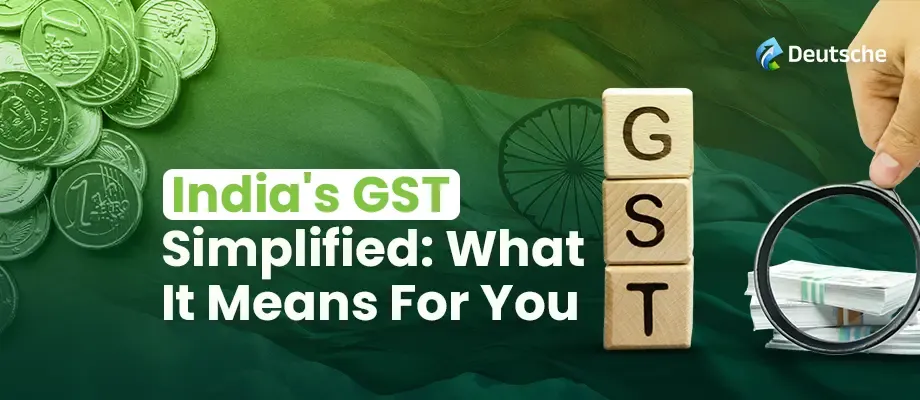During one of our most recent strategy meetings, the GST reforms 2025 that the Council announced this month came up for discussion. What caught my attention was not only the tax structure's simplification but also its goal behind lowering citizens' living expenses while providing businesses, especially MSMEs, with a more solid base on which to expand. A reform that goes beyond statistics is reflected in the switch to a two-rate system and the targeted relief in important sectors. This also signals a recent change in policy, with taxes being used primarily to encourage compliance, competitiveness, and inclusive growth.
The adoption of Goods and Services Tax (GST) in 2017 by India was a landmark moment in modern economic reform. As the forefront for eight years, the system has never deteriorated but has matured into a backbone of indirect taxation. The next-gen GST reforms announced in September 2025 mark another turning point, with a clear vision emphasising relief for the common man, competitiveness for businesses, and long-term growth for the economy.
There is far more to the shift to a simpler two-slab structure (5% and 18%) and the targeted relief for housing, healthcare, agriculture, necessities, and MSME inputs than a simple tax cut. My thought is that the goal of this structural reform is to boost consumption, make compliance easier, and strengthen India's standing as a growth-orientated economy.
What do the new GST rules mean for investors and businesses?
The new GST reduces uncertainty and controversies regarding classification and compliance expenses for most businesses, especially MSMEs and startups. As the new GST reforms reduce from four primary slabs (5%, 12%, 18%, and 28%) to two with a clear 40% for luxury and "sin goods," they are providing certainty. The simplification is such that businesses can plan operations, prices, and investments with certainty.
This type of policy certainty is essential at this time because companies are coping with dynamic consumer demand, inflationary pressure, and international supply chain uncertainty. Removing tax uncertainty is a powerful signal of stability that the government has sent, something that is essential for enticing domestic and overseas investment.
The major part that is affected by these reforms is the household relief that includes, lower GST on everyday goods like soaps, toothpaste, and packaged foods; zero GST on life-saving drugs and learning materials; and reduced rates for services like hotels, salons, and gyms.
These policies are lowering the cost burden on citizens, which has a multiplier effect. They have also made things more affordable, which encourages more consumption and boosts demand for consumer durables and automakers' cars. As a result, there will be an immediate effect on rate reduction. In sectors like housing, automobiles, and consumer durables, the rate reductions will not only revive demand but also accelerate job creation and economic activity.
Empowering MSMEs and Strengthening the Service Economy: Our Commitment as Leaders
The most significant achievement as a result of GST reforms in 2025 is the correction of inverted duty structures among key industries such as textiles, fertilizers, and agriculture equipment. Implementing these corrections will result in the following:
- Strengthen domestic manufacturing.
- Reduce import dependency.
- Improve competitiveness in exports.
The changes improve value addition in India and align taxes with the government's overarching goal of "Atmanirbhar Bharat" and manufacturing-driven growth by resolving long-standing irregularities. As a key contributor to GDP, some of the sectors are overseeing direct benefits through reduced GST on hospitality, wellness, and professional services. Rate reductions on inputs like cement, auto parts, and handicrafts help MSMEs cut expenses and become more competitive in the market.
Most significantly, return filing simplification, quick refunds, and digitized compliance processes decrease the friction in the MSMEs. It creates a more level playing ground, making it possible for the MSMEs to grow at a quicker pace and become part of supply chains without getting weighed down by the compliance.
The new reforms also need to be seen with a long-term perspective, as they are reducing rates, coupled with better compliance arrangements, expected to increase the tax base and revenues. India has already witnessed GST collections doubling in four years, and a cleaner, more simpler design will consolidate this trend.
As per the globacommitment to policy continuity al investors who are expecting for a change, the reforms are reaffirming India’s nd structural reforms which helps in balancing social welfare with economic growth. This balance is crucial for India as it positions itself as a major global manufacturing and service hub.
As I mentioned earlier, these reforms are mentioning major of the changes that are happening with specific industries. For instance, they have paved the way to the extent to which taxation, with a clear and inclusive design, can be a force for economic transformation. In helping to tackle affordability for families, competitiveness for businesses, and stability for investors at the same time, the reforms find a balance that makes India's growth story richer.
For companies, the initial challenge will be to examine pricing structures, supply chain, and compliance processes against the revised rates. For advisors and consultants, the challenge will be to guide companies through the transition by addressing these issues and realizing cost reduction and growth possibilities.
So my perspective on these latest reforms is that "Taxation is no longer just a tool to raise revenue; it is now about facilitating social protection and sustaining growth and economic momentum. The GST reforms for 2025 encapsulate this vision, positioning India's tax system not only as simpler and more equitable but also purposefully aligned with the country's longer-term developmental objectives."
